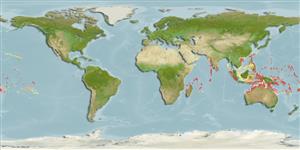>
Ovalentaria/misc (Various families in series Ovalentaria) >
Pomacentridae (Damselfishes) > Microspathodontinae
Etymology: Lepidozygus: Greek, lepis = scale + Greek, zygon = yoke (Ref. 45335).
More on author: Bleeker.
Environment: milieu / climate zone / depth range / distribution range
Écologie
marin récifal; non migrateur; profondeur 1 - 30 m (Ref. 30874). Tropical; 30°N - 23°S
Indo-Pacific: East Africa to the Line, Marquesan and Tuamoto islands, north to the Ryukyu Islands (Ref. 1602), south to New Caledonia (Ref. 37816).
Taille / Poids / Âge
Maturity: Lm ? range ? - ? cm
Max length : 10.5 cm TL mâle / non sexé; (Ref. 90102)
Description synthétique
Clés d'identification | Morphologie | Morphométrie
Épines dorsales (Total) : 12; Rayons mous dorsaux (Total) : 14 - 15; Épines anales: 2; Rayons mous anaux: 15 - 16.
Adults are found in current-swept seaward reefs; occasionally found around lagoon patch reefs. Form aggregations that feed on zooplankton (Ref. 9710). Oviparous, distinct pairing during breeding (Ref. 205). Eggs are demersal and adhere to the substrate (Ref. 205). Males guard and aerate the eggs (Ref. 205). Minimum depth reported taken from Ref. 9710. Diurnal species (Ref. 54980; 113699).
Life cycle and mating behavior
Maturité | Reproduction | Frai | Œufs | Fécondité | Larves
Oviparous, distinct pairing during breeding (Ref. 205). Eggs are demersal and adhere to the substrate (Ref. 205). Males guard and aerate the eggs (Ref. 205).
Allen, G.R., 1991. Damselfishes of the world. Mergus Publishers, Melle, Germany. 271 p. (Ref. 7247)
Statut dans la liste rouge de l'IUCN (Ref. 130435: Version 2024-1)
Menace pour l'homme
Harmless
Utilisations par l'homme
Pêcheries: sans intérêt; Aquarium: Commercial
Outils
Articles particuliers
Télécharger en XML
Sources Internet
Estimates based on models
Preferred temperature (Ref.
123201): 26.6 - 29.3, mean 28.5 °C (based on 2366 cells).
Phylogenetic diversity index (Ref.
82804): PD
50 = 1.0000 [Uniqueness, from 0.5 = low to 2.0 = high].
Bayesian length-weight: a=0.01259 (0.00497 - 0.03190), b=3.04 (2.82 - 3.26), in cm total length, based on LWR estimates for this (Sub)family-body shape (Ref.
93245).
Niveau trophique (Ref.
69278): 3.4 ±0.45 se; based on food items.
Résilience (Ref.
120179): Haut, temps minimum de doublement de population inférieur à 15 mois (Preliminary K or Fecundity.).
Fishing Vulnerability (Ref.
59153): Low vulnerability (10 of 100).
Nutrients (Ref.
124155): Calcium = 112 [68, 198] mg/100g; Iron = 0.895 [0.565, 1.414] mg/100g; Protein = 18.7 [17.6, 19.7] %; Omega3 = 0.16 [0.10, 0.26] g/100g; Selenium = 21.2 [12.0, 40.2] μg/100g; VitaminA = 232 [83, 620] μg/100g; Zinc = 1.7 [1.2, 2.4] mg/100g (wet weight);
